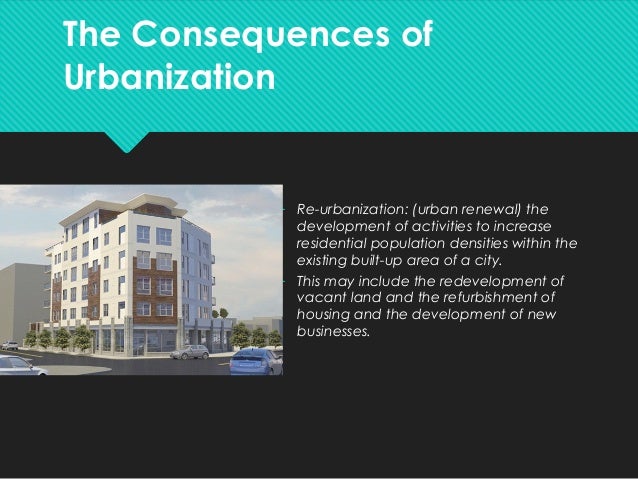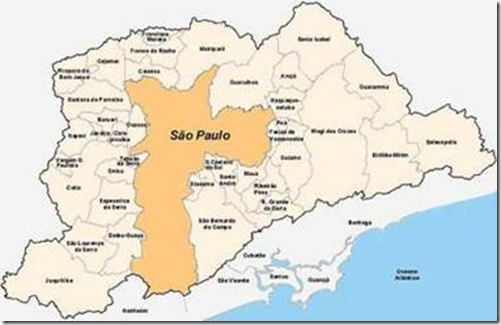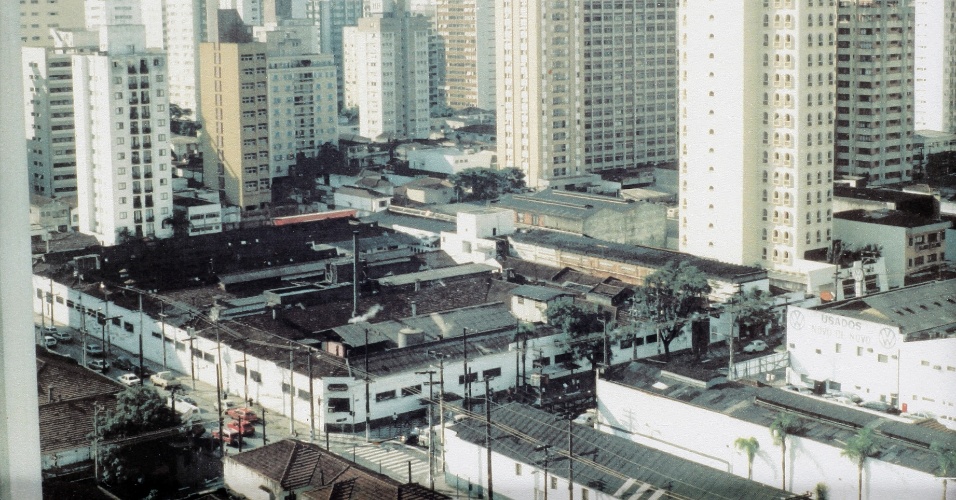Urban populations
Urbanization
Definition
The continuous process of transformation from being of RURAL to being of URBAN character, and the continuous change within the urban area itself as it grows by natural increase and by migration from other (usually rural) areas.
Source: Clark, Audrey N and Audrey N Clark. The Penguin Dictionary Of Geography. London, England: Penguin Books, 1998. Print.
Urbanization is caused by:
- Population growth
- Shift in the economic pattern
- Rural flight (rural-urban migration)
Percentage of urban population by country

Source: https://en.wikipedia.org/wiki/Urbanization_by_country#/media/File:Urbanized_population_2006.png Data from 2008.

Source: http://slideplayer.com/slide/6166586/
Inwards movement
Centripetal movements are INWARD movements. They most commonly are associated with either low income countries where rural to urban migration is bringing people into the city to avoid bad conditions in the hinterland, or high income countries where previously derelict areas are repopulated by young and wealthy residents. Centripetal movements can, of course, occur in all cities.
Rural-urban migration
For the reasons outlined in Core 1, migrants move to the city.
Source: http://geographylaunchpad.weebly.com/inward-and-outward-movements.html


Source: http://www.slideshare.net/stevenheath148/urbanization-centripetal-and-centrifugal-movements
Gentrification
Areas that were previously poor and probably derelict become popular among people with disposable income. These areas are usually in the old inner city.
Source: http://geographylaunchpad.weebly.com/inward-and-outward-movements.html

Source: http://www.slideshare.net/stevenheath148/urbanization-centripetal-and-centrifugal-movements
Reurbanisation and urban renewal
Neglected areas within the existing urban area are improved and redeveleoped. In some cases this is gentrification (the improvement of the existing housing stock, retaining most of the features of the area) but gentrification is usually driven by the 'organic' improvements that come about because places are popular among young professionals, while reurbanisation can be strongly influenced by planners. This latter type of improvement is often accompanied by deliberate planning for changes to services, employment opportunities, and transport networks.
Source: http://geographylaunchpad.weebly.com/inward-and-outward-movements.html


Source: http://www.slideshare.net/stevenheath148/urbanization-centripetal-and-centrifugal-movements
Suburban intensification: a type of urban renewal
This does not necessarily mean that high-rise buildings result. It can be simply that derelict buildings and empty space between buildings is redeveloped, so more houses fit in the same space. In addition, houses can be converted to apartments. This can be a gentrification movement, as young couples and singles move into an area and require less space.\
Source: http://geographylaunchpad.weebly.com/inward-and-outward-movements.html
Outward movement
Centrifugal movements are OUTWARD movements. They most commonly occur in countries where there is an increasing level of development in the early and middle stages, but can occur in all cities. The history of European and North American cities in the 19th and 20th centuries reflected this movement, creating the 'wealthy outer suburbs' of the Burgess model.
Surburbanisation
This is a decentralising movement as people move to larger, more spacious residential areas on the urban edge. This is partly due to overcrowding in cities that experience an increasing population. There are other reasons too, shared with counterurbanisation.
Counterurbanisation
The movement of people away from larger towns and cities to smaller settlements. Frequently people continue to rely on the large city for employment, services and so on. This is driven by several factors that can be associated with migration.
PUSH
- overcrowding
- lack of space for family groups to expand
- crime rates (although these are frequently stable or dropping, the perception of crime is that it increases)
PULL
- better quality environment
- better schools and other services
- cheaper housing cost allows greater use of space
REDUCTION OF OBSTACLES
- teleworking allows people to live in decentralised areas
- better transport infrastructure removes
- government planning for development of new towns increases the housing stock away from the larger cities
Source: http://geographylaunchpad.weebly.com/inward-and-outward-movements.html
Urban sprawl


Source: http://www.slideshare.net/stevenheath148/urbanization-centripetal-and-centrifugal-movements
Natural change
In recent years, cities have been expanding so far that they have started coalescing in some areas. For example, in the north-east of the United States, a continuous corridor of urbanization extends from Boston to Washington D.C.which also includes New York, Providence, Philadelphia and Baltimore.
Source: Codrington, Stephen B. Planet Geography. Adelaide: Solid Star Press, 2002. Print.

Source: http://enlimn4.rssing.com/noserver.html?a=12

Source: https://en.wikipedia.org/wiki/Northeast_megalopolis
This process whereby urban areas expand into each other to create huge metropolitan areas is called conurbation.
Source: Codrington, Stephen B. Planet Geography. Adelaide: Solid Star Press, 2002. Print.

Source: http://meioambiente.culturamix.com/noticias/o-que-e-a-conurbacao-das-cidades

Source: https://7bilhoes.wordpress.com/2011/11/page/2/
One way to reduce urban sprawl is to encourage urban consolidation. Urban consolidation is the process of increasing the density of residential buildings in an urban area. This can be achieved in several ways. For example, urban consolidation can be achieved by infilling gaps in an urban area, by bringing disused buildings (usually in the inner city) back into productive use, or by replacing buildings which can accommodate more people on the same land area. This last option is also known as intensification.
Source: Codrington, Stephen B. Planet Geography. Adelaide: Solid Star Press, 2002. Print.

Source: http://www.progresso.com.br/caderno-a/brasil-mundo/sp-tera-aluguel-social-inspirado-em-nova-york

Source: http://economia.uol.com.br/album/2013/09/06/fabricante-de-chocolates-finos-faz-85-anos.htm

Source: http://www.neptis.org/publications/implementing-residential-intensification-targets/chapters/intensification-setting
The global megacity
A megacity is an urban agglomeration (accumulation) with more than 10 million inhabitants. Sixty years ago in 1950, there were only two megacities—New York-Newark and Tokyo. In 1995, 14 megacities existed. Today, there are 22, mostly in the developing countries of Asia, Africa and Latin America. By 2025, there will probably be 30 or more.
Urbanization has been occurring in the developed countries of the West for 200 years. Since the Industrial Revolution, a period from the 18th to 19th century in which machine-based manufacturing grew tremendously, cities have grown rapidly. As technological innovations flourished, economies previously dependent on manual labor and draft-animals began to change. People moved into the cities to find work and relatively quickly, cities began to grow exponentially.
Today, the most rapid megacity growth is occurring in the world’s least developed and poorest countries—those least able to handle the political, social, economic and environmental problems associated with rapid urbanization.
In the most modern industrialized countries, on average, three out of four people already live within an urban area. In contrast, in the least-developed regions of the world, more than two out of three people still reside in a rural area. But that statistic is changing rapidly.
For people in developing countries, even the slums of cities like Mumbai, India, can offer more opportunities than their poor subsistence-based villages can. People gravitate to the cities because the potential for making money is greater there. While most of the economies in rural areas are agriculture-based with little cash flow, in the cities, people may be able to earn cash for work or retail sales.
Source: http://voices.nationalgeographic.com/2014/02/17/geography-in-the-news-the-growth-of-megacities/

Source: https://www.allianz.com/en/press/news/studies/151130_the-megacity-of-the-future-is-smart/

No comments:
Post a Comment